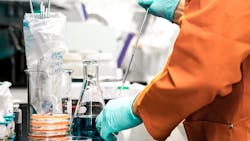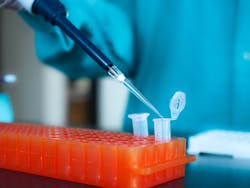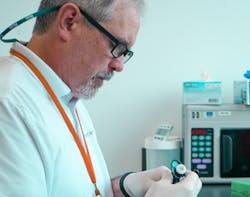Wastewater is a rich source of information for community health. It provides deep biological and chemical information on a community with fewer biases than many other types of public health surveillance.
The practice of using the information in wastewater for public health data is known as wastewater surveillance. When used specifically for diseases, it is also called wastewater-based epidemiology. It can be practiced in groups as small as passengers on an aircraft and communities as large as cities.
“But it actually isn’t a new technology,” says Anna Mehrotra, director of the Water Environment Federation (WEF)’s wastewater surveillance program. “There are papers looking at sewage surveillance for polio in 1939 in the United States, and it’s something that’s gotten a bit more attention since about 2001 when academic researchers started kind of talking about using wastewater to track pharmaceutical use and illicit drug [use].”
Wastewater surveillance has been used to track these items, as well as antimicrobial-resistance and chemical exposures, but it wasn’t until the COVID-19 pandemic that the practice saw an explosion in its popularity, since infected individuals shed SARS-CoV-2 (the virus that causes COVID-19) RNA in their feces. (Because the RNA is only a genetic remnant of the virus, those handling wastewater as part of their jobs are not at risk of infection.) Now, the practice is informing the public health efforts of several communities, while also being used to track new incidents of disease.
There are currently hundreds of wastewater surveillance programs with thousands of sampling sites worldwide. Wastewater surveillance is being carried out in at least 63 other countries, according to the COVIDPoops19 dashboard, an effort by University of California-Merced researchers to track COVID-19 wastewater data worldwide.
The most popular use of wastewater surveillance today has been for infectious diseases — but not only COVID-19. Several U.S. wastewater surveillance programs are now adding monkeypox, a viral disease related to smallpox, to their testing efforts.
Wastewater surveillance also helped detect the polio virus in New York State in June 2022. Wastewater data was able to detect the virus, which has the potential to cause permanent paralysis, much sooner than traditional testing. In August, wastewater data confirmed that polio was likely circulating undetected throughout New York City.
During the World Athletics Championships in Oregon in July, state officials used wastewater testing to anticipate signs of spikes in infections for hepatitis A, hepatitis E, measles, Middle East respiratory syndrome (MERS), and COVID-19. But the practice also has additional value.
“Our focus at WEF is on infectious disease, but there is a lot of great work going on around the globe looking at other targets for wastewater surveillance related to health,” says Mehrotra. “For example, in Israel, their Ministry of Health has started to use wastewater to look at nicotine consumption and biomarkers for depression and diabetes in the population. And this is in addition to their ongoing wastewater surveillance for COVID-19 and polio.”
How It Works
Though there are several testing options and tests available, there is no central, generally agreed upon process or procedure for a wastewater testing program. Many programs involve a collaboration between wastewater utilities, laboratories, and local and state health departments. Utilities can provide sample collection and sewer system/flow information, laboratories can provide the testing and analysis, local health departments can provide data interpretation and interventions, and the state health department can provide funding and guidance.
Samples, collected as wastewater flows into a treatment plant, can be collected by hand — some studies, however, have used commercial auto-sampling robots to collect these samples instead.
“There’s a lot of different [testing] methods: you’ve got ddPCR, you’ve got quantitative PCR using TaqMan assays, you’ve got sequencing — each of these things bring a ton of power to the picture,” says Robert Brooks, a research director for Microbac Laboratories, a Tennessee-based laboratory that offers testing services for wastewater utilities. “The problem is, they don’t all work in the same sandbox or work with the same mix.”
For wastewater systems that don’t have access to a lab, there are also several on-site, rapid testing options, some of which can deliver results within one to six hours and can cost as little as $10 per test.
However, before data analysis can begin, the test results need to be adjusted for several factors, such as sewer system size, testing time, recent flow rates, historical wastewater data, and the number of recently identified clinical cases.
“That is one of the things with technology nowadays; we can generate so much data,” says Brooks. “The problem is: what context are we using to now look at that data and to generate a final output? Because that context matters greatly.”
In tracking diseases like COVID-19, viral RNA in wastewater can be a leading indicator of the disease’s presence, which helps local health departments take swift action. When adjusted for all these variables, however, the lead time between wastewater detection and case spikes can vary anywhere from zero to 14 days.
But even when a system’s data won’t provide early warning, it can still help predict whether the disease is declining: if viral loads in wastewater are dropping, cases could soon decline; if loads remain steady, cases will likely remain steady.
There are several good reasons for a community to invest in wastewater surveillance. When it comes to infectious diseases, wastewater data has benefits where traditional, individual testing alone can fall short.
“This technique is especially important now given that cases of COVID-19 might go undetected as more people are using rapid at-home antigen tests and cases are not being reported to state health departments,” says Danielle Carlin, a program administrator at the National Institute of Environmental Health Sciences (NIEHS). “In addition, the surveillance can be performed without having to directly measure exposure in humans and is faster and less expensive compared to clinical testing.”
Wastewater surveillance can also require fewer resources than traditional testing, which often needs more personnel, space, and equipment.
Traditional disease testing only includes data for people who have access to testing and who consent to testing procedures. Wastewater surveillance, on the other hand, provides a steady stream of information from the nearly 80 percent of U.S. households that are served by municipal wastewater collection systems. This makes the practice anonymous, more inclusive, and less invasive than traditional testing methods.
The Drawbacks
Though groundbreaking, for every benefit, wastewater surveillance testing has several limitations.
The uncontrolled parts of a wastewater distribution environment bring a host of complex challenges to data. For example, the practice can’t track systems that pre-treat wastewater before it reaches the plant. Communities with high levels of tourism can have skewed results. Combined sewer systems will have a harder time with surveillance because they need to accommodate for rain events.
Sometimes, even when a pathogen has been detected in wastewater, the data cannot inform action until more research is conducted.
With novel diseases, researchers can’t be sure how accurately wastewater anticipates the disease’s spikes — or even reflects its cases — until testing and research can corroborate the numbers. This is currently the case with monkeypox: while the virus can be measured in wastewater, researchers aren’t yet certain whether these viral levels can anticipate case surges. Whether wastewater data can precede monkeypox surges will depend on the yet-uncertain timing between viral shedding and symptom onset.
There are also limits to what even successful monitoring can accomplish. Viral data in wastewater doesn’t pinpoint who is infected; it only reveals the presence of the disease in a general area.
Every health surveillance practice has limitations. Where traditional testing is slow, wastewater surveillance is fast — but where wastewater surveillance is vague, traditional testing is precise. Wastewater surveillance is only part of the solution for disease monitoring. It works best as a complement to existing surveillance systems and, where it can, as an early warning signal.
Wastewater Surveillance in the U.S.
The Centers for Disease Control & Prevention (CDC)’s National Wastewater Surveillance System (NWSS), launched in September 2020 in response to the COVID-19 pandemic, is one effort to provide a robust platform for community-level disease surveillance.
“The NWSS data system provides consistent data analysis and results reporting that health departments can use to support their COVID-19 response,” says Amy Kirby, NWSS team leader. “CDC is focused on providing quality data, support, and technical assistance to health departments, laboratories, and utilities that collect and use wastewater data.”
The NWSS system was developed to help coordinate and build communities’ ability to track the virus in wastewater samples. In this way, independent local efforts can contribute to development of a standard national surveillance system.
“As of July 2022, more than 1,000 testing sites across 46 states and five cities are reporting wastewater surveillance data for COVID-19 to CDC’s NWSS,” says Kirby. “These contributing sites serve more than 130 million people.”
CDC’s NWSS has funding designated through 2025 to help systems implement surveillance through the Epidemiology & Laboratory Capacity (ELC) program. A commercial testing contract is also underway by CDC to provide free wastewater testing to 500 facilities for 12 months.
Through the NWSS, CDC plans to focus on four areas: emergency response, emerging infections, pandemic preparedness, and bioterrorism. CDC also has priority pathogens that it plans to target with NWSS: antibiotic resistance genes, foodborne bacteria, norovirus, Candidia auris, influenza, RSV, and hepatitis A.
Another project comes from scientists at Stanford University, who helped launch the Sewer Coronavirus Alert Network (SCAN), which collaborates with several wastewater plants and public health agencies. The project launched in November 2020 and is now monitoring communities in 38 cities across eight states. It plans to grow to eventually include 300 U.S. sites.
The SCAN team expanded its surveillance in mid-June to account for monkeypox. It was the first organization to report detection of genetic markers of the monkeypox virus in U.S. wastewater. Currently, 38 treatment plants are receiving monkeypox results from SCAN in addition to their regular COVID-19 monitoring. Monkeypox DNA has been found in 22 of those locations.
The Future of the Practice
As health departments and public health laboratories develop wastewater surveillance coordination, epidemiology, and laboratory capacity, the practice will continue to grow beyond efforts related to COVID-19. It has already proven useful in tracking outbreaks of other diseases, new research is continuing to improve the practice, and the programs that support wastewater surveillance have plans for major expansion, including efforts at the CDC.
Mehrotra says that WEF is also working on developing utility engagement: understanding utility needs and helping them participate in these surveillance programs without overburdening wastewater workers.
Research in wastewater surveillance is seeing rapid growth, too, which reflects the practice’s potential.
“Hopefully in the next few years we will have a much more robust capability to use wastewater surveillance as an early warning signal [for infections],” says Carlin. “As this technique is still in the developmental stages, there is need to study trends and understand why sometimes the wastewater surveillance is predictive of an outbreak and why, sometimes, it is not predictive.”
These improvements to wastewater surveillance will help health professionals prepare for an inevitable challenge: the next major pandemic. When that time comes, wastewater surveillance could be a significant tool in our collective response. WW
Published in WaterWorld magazine, September 2022.
About the Author
Jeremy Wolfe
Jeremy Wolfe is a former Editor for WaterWorld magazine.



